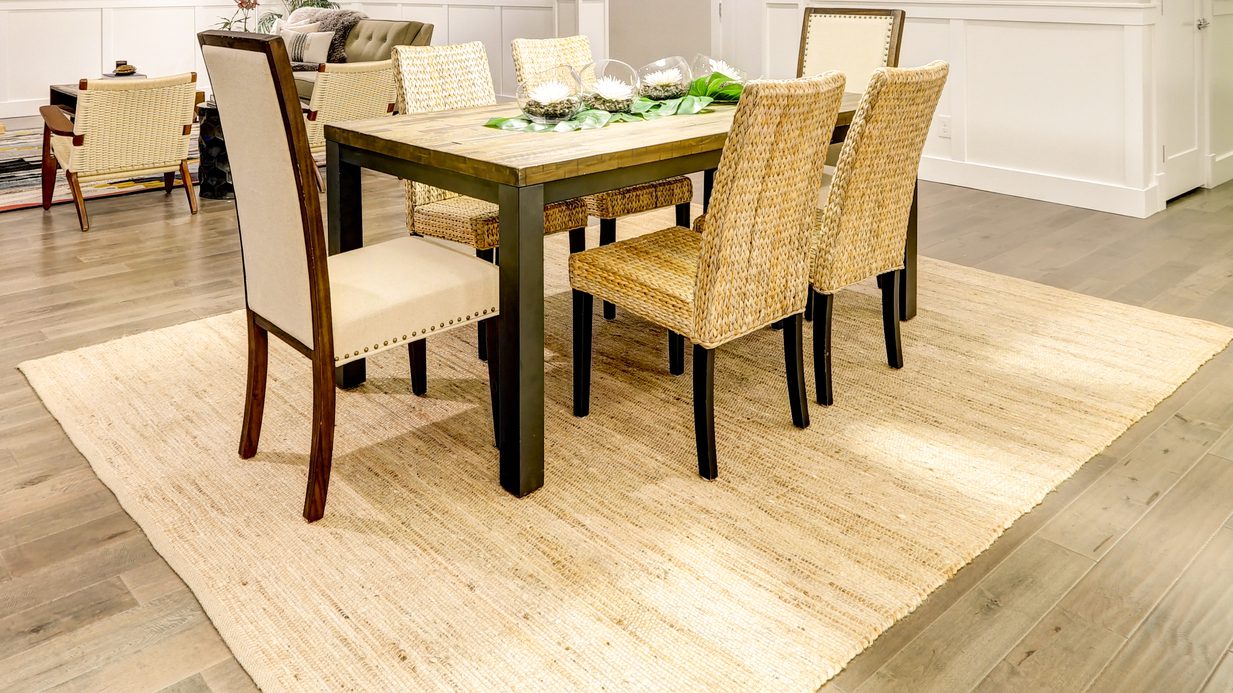
irina88w/iStock
You’ve probably read that the rug you place under your furniture should tie the room together, as well as offer warmth and softness underfoot. But carpets can be costly, and if you’re trying to go green, rugs that are made from synthetics are often petroleum-based and far from eco-friendly.
The solution: natural fiber rugs, made from jute, abaca, hemp, and other plants. These rugs are only lightly processed, which means you’ll spot the character of the raw materials. And for their proponents, that translates into interior beauty.
“These looks are made from renewable fibers, which lend a beautifully textural weave and a relaxed feeling to any room,” notes Karen Gray-Plaisted of Design Solutions KGP.
While these rugs are lovely in their natural state and make an ideal neutral foundation in most rooms, they can also be dyed.
“And a big trend is to layer an animal hide over a plant fiber rug, which is cost-effective if you have a large space to cover,” Gray-Plaisted notes. We show an example below with a seagrass rug.
Here’s more about natural fiber rug types, as well as how to care for them and where to use them in the home.
Abaca
Merida
Abaca is produced from the trunk of a tree that’s very similar to the banana tree.
“The outer layer of the trunk produces a darker fiber, and the inner layer gives a bright, pearl-like color,” explains Zairo Cheibub, director of research and development at Merida.
While this natural fiber rug is very durable, it’s best reserved for low-traffic areas, because the construction is not as tight, he adds.
Skip dining rooms, as the back-and-forth motion of your dining chairs will soon leave marks.
Jute
Jute, cultivated mostly in India and Bangladesh, comes from the stalk of the plant, rather than the leaf, so it’s softer to the touch.
“The plant is soaked in water to soften and separate the fibers,” Cheibub explains.
Jute gets a bad rap, since it is mostly known as the raw material for burlap and twine, which are much rougher. It’s much less harsh to the touch, and its comfy qualities make it a great pick for bedrooms and hallways.
Jute is easy to clean, very affordable, and neutral in color, making it a good pick for any room, even those that see high traffic, says Drew Henry of Design Dudes.
Sisal
Sisal fibers come from the agave, the same cactuslike plant that brings us tequila. Sweet!
“It’s originally from Mexico, but the best sisal today is produced in Africa,” Cheibub reports.
Rope and twine are also sometimes made from sisal, so it’s quite tough and durable. Its coarse texture means that it’s not as comfy underfoot, but its durability allows it to take a beating in busy areas, says Gray-Plaisted.
Sisal is a malleable fiber, and can be used to produce exquisite patterns, and it’s more tightly woven than jute and abaca, so it can be used in stairways and dining rooms, notes Cheibub.
Just be careful with the red wine, the pros warn, as these fibers are absorbent and can stain.
Seagrass
Seagrass, on the other hand, is water-resistant and will repel most stains.
“The fiber comes from grasses that grow in saltwater marshes,” says Gray-Plaisted. It’s also softer than sisal, so it’s a good choice in a bathroom, bedroom, or the kitchen.
You’ll mostly find seagrass rugs in neutral colors, as they don’t absorb dyes, though some may have a border around them that comes in various shades.
The beauty of these basic background rugs is that you can accessorize seasonally, swapping out smaller topper rugs and pillows to complement these beige-brown fibers.
Hemp
Photo by GRADY-O-GRADY Construction & Development, Inc.
Hemp is the elder statesman in this bunch, with centuries of history in the United States.
“When the settlers came to America, England insisted that Colonists dedicate an acre of hemp for every 60 acres of their farmland, because it was a rather valued crop and could be used to pay taxes,” notes Gray-Plaisted.
Although hemp isn’t as soft as jute, the fibers will relax over time and become easier on your feet.
“A hemp rug is durable, mildew-resistant, and can be dyed,” she adds.
Caring for natural fiber rugs
Photo by Andrew Howard Interior Design
Regular vacuuming is essential to pick up dirt and grime that can become embedded in the fibers of your natural carpeting. But because these rugs don’t hold up well to lots of moisture, traditional stain-removing cleansers and agents aren’t recommended.
Instead, try a gentle DIY solution of a teaspoon of detergent with one teaspoon of distilled white vinegar, mixed with 2 quarts of warm water.
Dampen a rag and carefully blot the stain; dry thoroughly by rolling the rug up with a large bath towel and squeezing gently.
The post What Is Jute—or Abaca? Why Natural Fiber Rugs Are All the Rage appeared first on Real Estate News & Insights | realtor.com®.





No comments:
Post a Comment